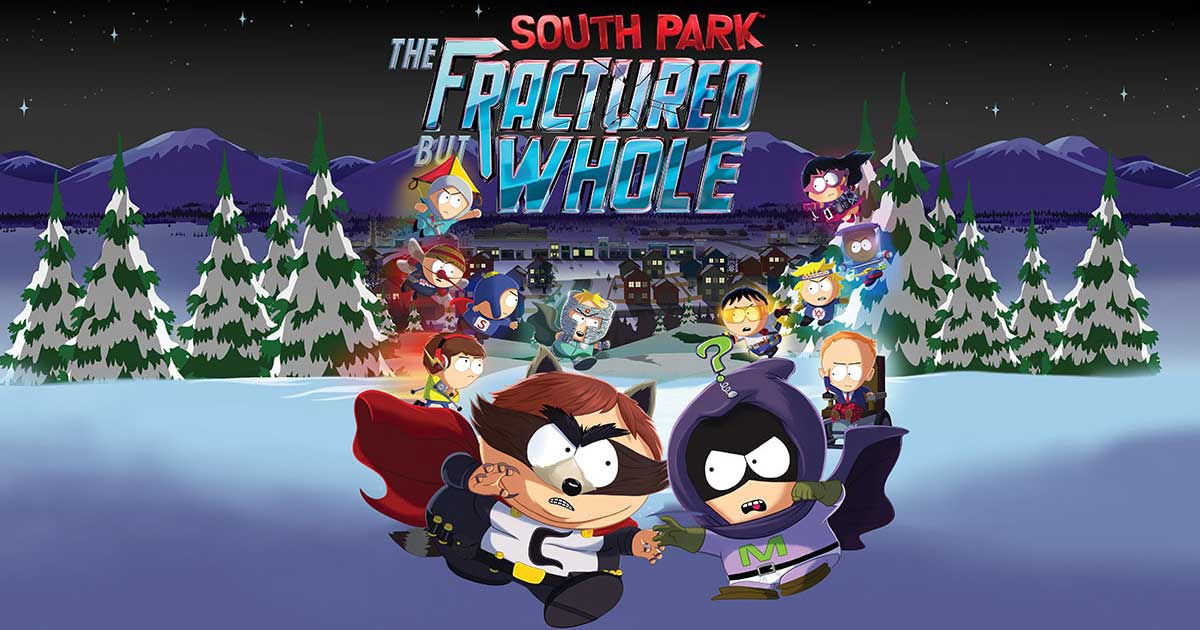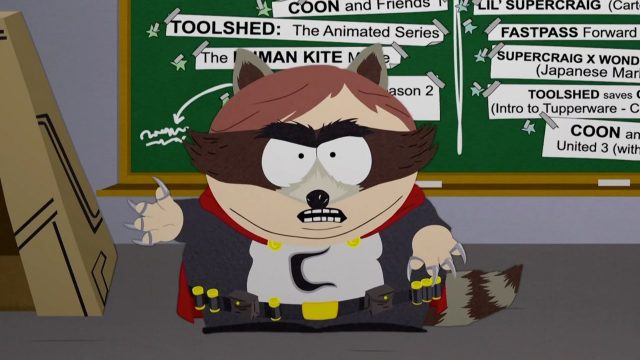
Many cats have disappeared in a town that doesn’t sleep, prompting at least one worried owner to offer a massive, $100 reward for information. It’s a mystery, but a seemingly simple one, and it seems right up the alley for Coon and Friends, who want to pocket the money and put it towards their plans for cinematic domination.
This is the mystery that keeps Cartman and company away from their beds in South Park: The Fractured but Whole, Ubisoft’s follow-up to the masterpiece that was 2014’s The Stick of Truth. Thus, the question that then remains is whether this particular, cuss-filled adventure, is better or at least comparable to its widely successful and very beloved peer.
Things resume during an extended game of The Stick of Truth. One that is quickly quashed by a change of heart, after Cartman (or Coon as he prefers to be called) makes an appearance in his superhero costume and urges both his friends and frenemies to switch gears and take on a new quest. What results is a colourful campaign that is driven forward by not only the search for the lost cats, but also Cartman’s greed. His unwavering wish to turn himself, his friends and all of their alter egos into massive movie stars, through superhero-themed films and Netflix specials. Screw the Freedom Pals, who make up some of the opposition, as the rival group containing the likes of Timmy and Stan. They’re doomed to failure in Cartman’s eyes, and don’t deserve to have their own theatrical empire, because they’re simply not as good.
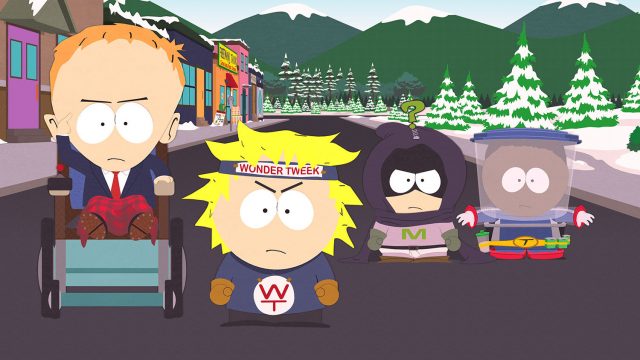
Although this rivalry between the Coon and his former pals carries through The Fractured but Whole, it’s somewhat of a secondary storyline that adds depth to the experience. While Cartman and company are doing their best to figure out who, if anyone, is behind the plethora of missing felines, his attention is often swayed by thoughts of dominance over those he sees as being inferior. It doesn’t help, of course, that Stan is seen as a traitor.
Once again, the player controls ‘The New Kid;’ the nameless transplant whose customized appearance and interchangeable costumes allow him (or her) to become the newest and most important member of this ragtag group of imaginary superheroes. ‘Douchebag’ is no more, however, as Cartman now prefers to call his newfound and very silent peer ‘Buttlord,’ although the name ‘Butthole’ is also thrown around a lot. There’s no negative response to this, either — it’s just taken in stride, probably because Cartman is Cartman and he says a lot of rude shit. The New Kid never really says a thing, though, and even when he does, it’s done through text-based decisions. Alas, even those are limited, and are mostly made up of choices relating to the type of character you would like to be and which gender, sexual preference and ethnicity you identify with.
Yes, in familiar Matt Stone and Trey Parker fashion, South Park: The Fractured but Whole takes on global issues and social justice concerns in its own unique way. This leads to some rather comical scenes with the school counselor and the new, PC Principal. Microaggressions be damned.
On top of being fun to play, what allowed The Stick of Truth to stand out and endear itself to so many people was its well written storyline and great humour. Most of this extends to The Fractured but Whole, but, disappointingly, this sequel doesn’t reach the same plateau as its predecessor did. The gameplay remains fun, the world continues to be humorous, and there’s lots of enjoyment to be found, but I’d be lying if I said that it didn’t feel like a bit of a step back in terms of combat design and narrative. This seems to be the result of the developers having tried to do a bit too much, as the storyline sometimes suffers from a lack of focus and the battle mechanics lack a wow factor.
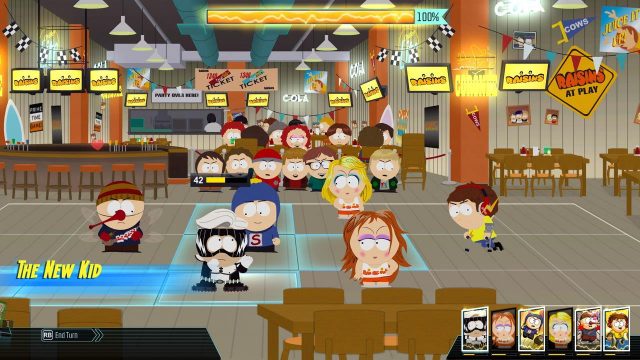
Combat takes a new form here, with a grid-based approach that mimics strategy role-playing games, albeit without the same level of depth (which is to be expected, and isn’t exactly a bad thing given the subject matter). Herein, players take control of up to several different superheroes, in a system that limits each character’s available movements and restricts them in turn-by-turn fashion. Simply put, a queue is shown at the bottom of the screen and it dictates who goes when and in what order, unless a character is revived and is thus given a chance to heal or move immediately afterwards. You can use one item or perform one attack per turn, and can also move within a set amount of blue-hued squares.
Moves take varied forms and offer different options depending on which class the kid you’re controlling happens to be from. Coon, for example, comes equipped with claws that he can use to lunge at and tear apart enemies with, causing them to bleed for the next couple of turns. Kyle, then, is the Human Kite, who uses the power of wind and can heal allies, while Jimmy is Fastpass, a speedster who can be used to swap places with others (while also acting as the game’s fast travel system, in comedic fashion). As a whole, the group presents a good amount of variety and a decent amount of choice, since you can only use up to four per battle and must choose who prior to each one.
The New Kid begins his super-heroic life as a nobody, but eventually evolves into a somebody who’s able to pick, choose and mix different classes. Options include the almighty brawler, the blazing speedster, and the precision-loving blaster, but there are actually quite a few others to choose from, including a plant whispering healer. At the end of the game, I had a nice mix of brawn, fire (multiple fireballs that could burn foes, and a wall of fire that would push them back) and tech, which gave me the ability to create turrets and combat dummies. Your New Kid will likely be quite different, however, and that’s a good thing.
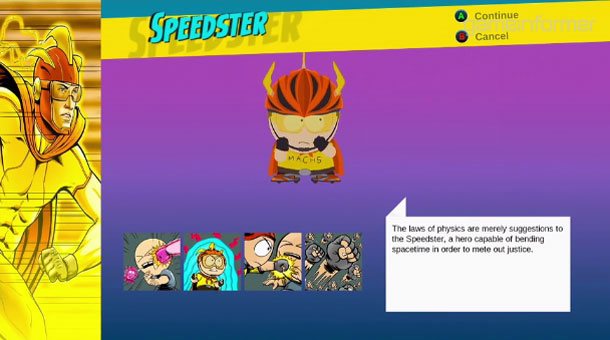
It goes without saying, then, that the team you’ll favour will complement the type of player that you are. It’s good to have a nice mix of classes, but everyone will favour something different. I found Cartman to be particularly helpful, because of his bleed status effect, and also liked having the option to use another character’s far-reaching laser eyes to pick off distant foes. A healer was also important, even though consumables were in great supply (and could easily be crafted using things like plastic bottles, soft taco shells, food items and duct tape.)
Like Nintendo’s Paper Mario franchise, combat in The Fractured but Whole tasks those in control with pressing a button to both increase and negate damage. Offensive moves present up to a few repeated taps of the A button which, when done correctly, can bolster the amount of damage you deal out and also increase your special bar. Defense, then, is very similar, except you’re trying to press A to lessen the amount of health you’ll lose after being beaten upon by one of many different types of enemies. Success can lead to early availability of your ultimate attack, which varies by character and is never locked to one specific kid. It’s unlocked as a collective group, and can then be used by any of its members. Or not at all, if it’s deemed unnecessary.
Around the mid-way point, it’s learned that the New Kid has one super powerful ass. So much so that his farts can not only make people sick, but can also be used to bend time as only South Park flatulence can. This allows him to erase an enemy’s move during battle, turn day into night or pause time and dole out some unfair damage. Said mechanic is limited use, though, and takes three or four turns to refresh. Similar to this are the game’s summons, which let you use macaroni art to ask Judaism for healing help, page a drunk driving stripper or call in Kyle’s mostly naked dad, who happens to have a bomber plane at his disposal. What’s different is that, unlike the time-bending flatulence, summons can only be used once per battle, and the macaroni one requires you to either find or craft the artwork out of consumables you’ve found or purchased. Don’t worry, though, because there are tons and tons of things to find in every cupboard, drawer, trash can, bag, chest and purse in town.
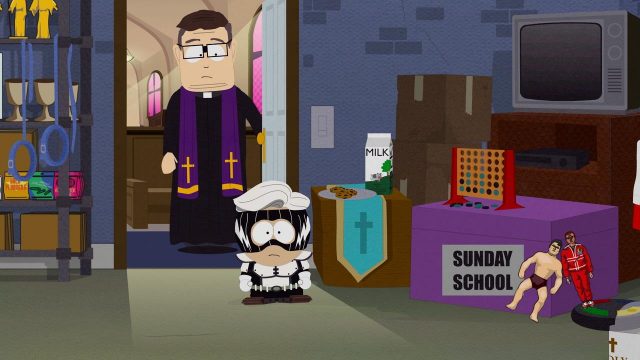
The combat system is far from bad, but it’s not great and ultimately leaves something to be desired. It’s a bit too basic, can get quite repetitive, and isn’t as upbeat or as fun as one would hope. The feeling that it was too similar to many mobile games also entered into my head more than once. Things do get better and more complex later on, though, as breakable, explosive and immovable barriers come into play, but even then it still felt like something was missing. That said, combat is sometimes optional (you can choose to engage or avoid certain foes), but it is important for raising one’s hero rank.
In addition to being able to pick your powers, you can also choose which costume you’ll wear and can change each part whenever you’d like. Different costume patterns and pieces are found throughout the game world, and are easily crafted using just one ingredient. The developers missed out on something special here, however, because the costumes that the New Kid wears only affect his appearance. In a perfect world, there would’ve been less costumes and more (narrative and gameplay based) meaning behind each one. Perhaps they could’ve been restricted to certain classes, and could have altered the player’s moves when worn. Or, at the very least, been referenced in dialogue.
Maybe I’m asking for too much, though.
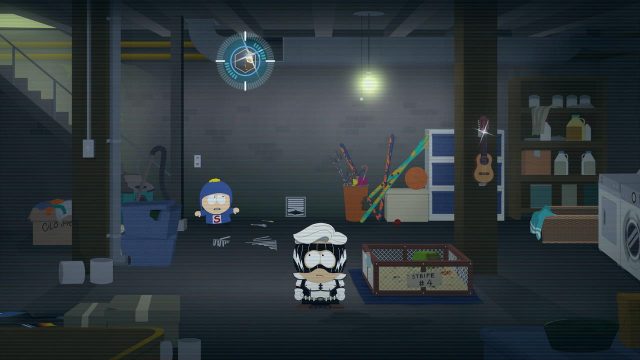
Another thing that aids your party is artifacts, which are special (and sometimes disturbing) items that carry their own attribute-boosting powers. Every artifact that you find, craft or earn will come bearing perks and its own might rating. They’ll start low, at 10 or 15, but will end up past 100 near the end of the game. Your best bet is to constantly be on the lookout for them, in shops, vending machines and in your crafting menu, with the goal of equipping the highest ranked ones that you possibly can. Several slots will eventually be available, and all of the artifacts that fill them will always combine to make up your overall might rating, which factors into combat, while also giving your party skill boosts.
Over the course of this fifteen hour-long experience, you’ll run rampant throughout South Park and talk to most of its more familiar faces, with some hilarious results. Some will factor into the main quest, while others will offer their own quirky side quests (like posting head shots around town, saving the town’s mobile store from crab people, standing up to anyone who criticizes your gender, race or sexuality, and finding graphic Japanese Yaoi featuring some familiar boys). The rest will be there to talk to, or perhaps even fight, as is the case with one particular mom.
Collectibles are plenty, and like special chests, some are hidden behind breakable walls or appliances that can be pushed over to create new pathways. It’s also possible to press the left trigger, move the resulting cursor around and either throw farts (at flames) or firecrackers (at glowing cracks, breakable items or animals) to create damage and alter the local landscape. Eventually, the New Kid will also have the option to use Fartkour to fart his way to the tops of buildings, or use the power of farts (and a helpful power tool) to get rid of the lava that blocks multiple pathways.
Potentially offensive potty humour carries throughout this quirky campaign, as one would expect, and is also found in every bathroom in town. Why’s that? Well, each and every toilet carries its own pooping challenge, wherein one must move and rotate joysticks or repeatedly press buttons to pull off the perfect poo. Different commodes carry different difficulty ratings, and some can be pretty tough. It’s always worthwhile, though, because these smelly bio-hazards can be used or sold.
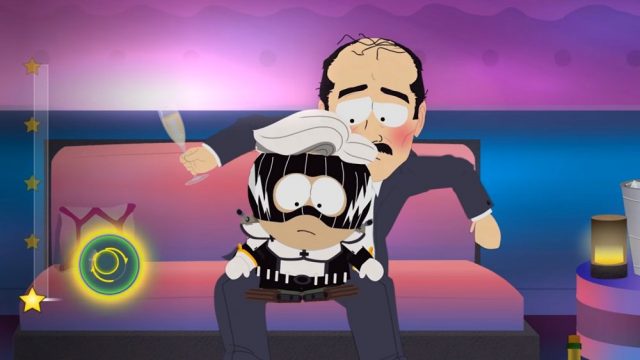
Quests are kept track of on the map screen, through a somewhat clunky system that is often a pain to use. Though South Park is somewhat small and constricted, it has quite a few buildings to explore and places to visit, yet its map is small and hard to read. You can also only fast travel by going to one fast travel post and asking to be taken to another via the map.
You’ll get used to it, though.
Progression isn’t just based around combat, nor is exploration its only other facet. In actuality, one of your main goals is to spread your influence around town. This is accomplished by talking to people and asking those with camera icons above their heads if they’d be willing to take a selfie with you. Getting a picture of yourself and another person then gifts you with a new follower, and results in the photograph being posted to Coonstagram, Cartman’s Instagram-esque app that he’s spread around town. Some folks will do so without a hassle, but others will require you to be a certain class, or want you to have completed a certain task.
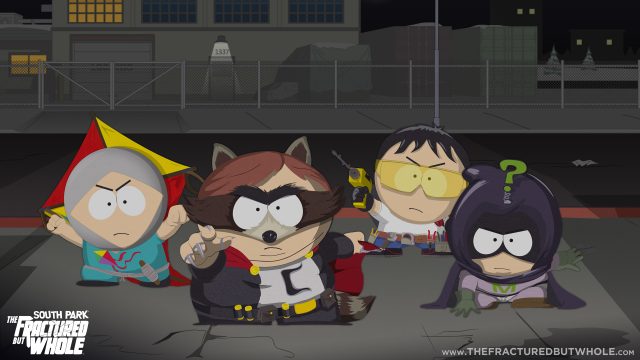
Moving on, some rather basic progression puzzles and grotesque minigames will need to be bested in order to make one’s way closer to the credits. Nothing about this game is overly tough, though, unless you purposefully make it that way by choosing the most challenging difficulty. Speaking of that, it’s important to note that, much like the police sidequests that task you with entering black folks’ homes and beating up their ‘gangster’ or ‘drug lord’ patriarchs, South Park: The Fractured but Whole‘s difficulty level is based around racism. Thus, choosing to be a very white kid will make things easy, while opting to be a much darker skinned protagonist will default to hard mode. This is a tongue-in-cheek, yet rather fitting system, but don’t worry too much about it because combat difficulty can be toggled through the options menu at any point.
Presentation-wise, things are pure, unadulterated South Park, with lots of swearing. Playing this game makes you feel like you’re inside of an organic but scripted episode, which is something that’s been accentuated by the true to source visuals and audio. Fans of the series will feel right at home here as a result, and gamers will welcome the short loading times that accompany things. I did encounter the odd glitch (a character standing still for 30 seconds before dying, a line of dialogue not playing, a small bit of frame rate slowdown in one part of the town), but never anything major or anywhere close to game breaking. For the most part, this much anticipated sequel ran very well on the Xbox One.
In conclusion, South Park: The Fractured but Whole is a very solid sequel, which is well worth your time and money, especially if you happen to be a big fan of its source material. The Stick of Truth it is not, but one must consider how tough it would’ve been for the developers to have surpassed that masterpiece. Although this sequel meanders a bit much and suffers from a convoluted storyline, it’s another win for Ubisoft and the folks over at South Park Digital Studios.
**This review is based on the Xbox One version of the game, which we were provided with.**

